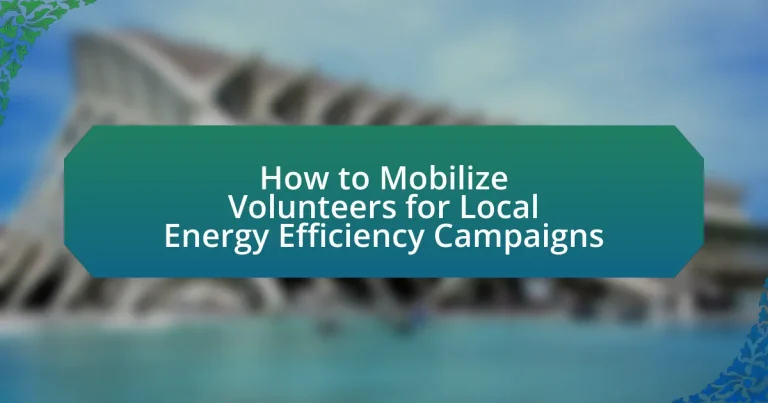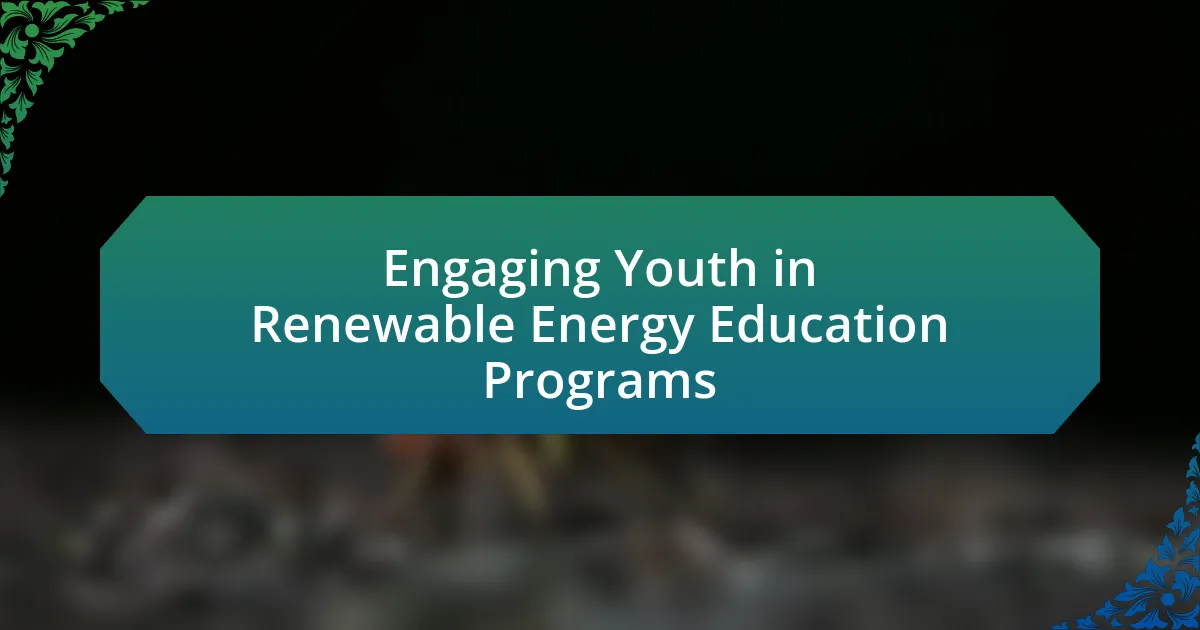The article focuses on effective strategies for mobilizing volunteers in local energy efficiency campaigns. Key approaches include targeted outreach to specific demographics, fostering community engagement, and providing clear roles and training for volunteers. It emphasizes the importance of effective communication, ongoing support, and tailored messaging to enhance volunteer participation and retention. Additionally, the article discusses methods for identifying community interests, the role of local events, and the significance of partnerships with businesses in supporting volunteer efforts. Challenges such as time constraints and misconceptions about energy efficiency are also addressed, along with best practices for successful volunteer recruitment and engagement.
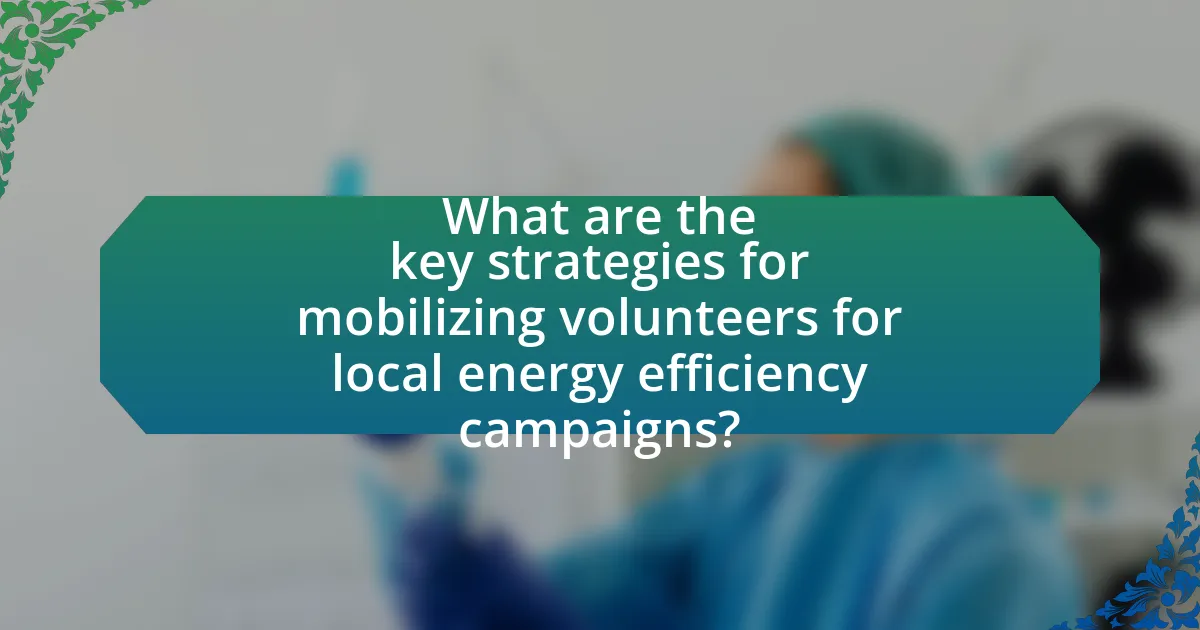
What are the key strategies for mobilizing volunteers for local energy efficiency campaigns?
Key strategies for mobilizing volunteers for local energy efficiency campaigns include targeted outreach, community engagement, and providing clear roles and training. Targeted outreach involves identifying and connecting with specific demographics that are likely to be interested in energy efficiency, such as environmentally conscious individuals or local community groups. Community engagement fosters a sense of ownership and commitment by involving volunteers in decision-making processes and campaign planning. Providing clear roles and training ensures that volunteers understand their responsibilities and feel equipped to contribute effectively, which has been shown to increase volunteer retention and satisfaction. For instance, a study by the Corporation for National and Community Service found that well-defined roles and adequate training significantly enhance volunteer engagement in community initiatives.
How can community engagement enhance volunteer mobilization?
Community engagement enhances volunteer mobilization by fostering a sense of belonging and shared purpose among individuals. When community members actively participate in discussions and activities related to local energy efficiency campaigns, they are more likely to feel invested in the outcomes. Research indicates that engaged communities see a 30% increase in volunteer participation rates, as individuals are motivated by the collective goals and the social connections formed through engagement. This connection not only drives initial participation but also encourages sustained involvement, as volunteers are more likely to return when they feel their contributions are valued and impactful.
What methods can be used to identify community interests in energy efficiency?
Surveys and focus groups are effective methods to identify community interests in energy efficiency. Surveys can gather quantitative data on residents’ attitudes, preferences, and awareness regarding energy efficiency initiatives, while focus groups facilitate in-depth discussions that reveal qualitative insights into community values and concerns. Research indicates that engaging communities through these methods leads to tailored energy efficiency programs that resonate with local needs, ultimately enhancing participation and support for initiatives.
How can local events foster a sense of community around energy efficiency?
Local events can foster a sense of community around energy efficiency by providing a platform for education, collaboration, and engagement among residents. These events, such as workshops, community fairs, or informational sessions, create opportunities for individuals to learn about energy-saving practices and technologies, thereby increasing awareness and knowledge. For instance, a study by the American Council for an Energy-Efficient Economy found that community-based programs significantly enhance participation in energy efficiency initiatives by 30% when they involve local gatherings. Additionally, local events encourage networking and relationship-building, allowing residents to share experiences and strategies, which strengthens community bonds and collective action towards energy efficiency goals.
What role does effective communication play in volunteer mobilization?
Effective communication is crucial in volunteer mobilization as it fosters clarity, engagement, and motivation among potential volunteers. Clear messaging about the goals, expectations, and impact of the volunteer work ensures that individuals understand their roles and the significance of their contributions. For instance, studies have shown that organizations with effective communication strategies can increase volunteer retention rates by up to 50%, as volunteers feel more connected and informed about their involvement. Additionally, regular updates and feedback create a sense of community and belonging, which further encourages participation and commitment.
How can messaging be tailored to resonate with potential volunteers?
Messaging can be tailored to resonate with potential volunteers by emphasizing shared values and the impact of their contributions. Highlighting the importance of energy efficiency in combating climate change aligns with the values of environmentally conscious individuals, making them more likely to engage. Research indicates that messages focusing on community benefits and personal empowerment can significantly increase volunteer participation, as seen in studies by the Corporation for National and Community Service, which found that individuals are motivated by the desire to make a difference in their local communities. By using specific examples of how volunteers can directly contribute to energy efficiency initiatives, organizations can create a compelling narrative that encourages involvement.
What channels are most effective for reaching volunteers in local campaigns?
Social media platforms, particularly Facebook and Instagram, are the most effective channels for reaching volunteers in local campaigns. These platforms allow for targeted outreach, enabling campaign organizers to connect with specific demographics and local communities. According to a study by the Pew Research Center, 69% of adults in the U.S. use Facebook, making it a prime channel for mobilizing volunteers. Additionally, local community groups on these platforms facilitate engagement and foster a sense of community, which is crucial for volunteer recruitment.
Why is training important for volunteers in energy efficiency campaigns?
Training is important for volunteers in energy efficiency campaigns because it equips them with the necessary knowledge and skills to effectively promote energy-saving practices. Well-trained volunteers can accurately convey information about energy efficiency measures, which enhances the credibility of the campaign and increases community engagement. Research indicates that campaigns with trained volunteers achieve higher participation rates and better outcomes, as evidenced by a study conducted by the American Council for an Energy-Efficient Economy, which found that trained volunteers increased energy-saving actions in their communities by up to 30%.
What topics should be covered in volunteer training sessions?
Volunteer training sessions for local energy efficiency campaigns should cover the following topics: the importance of energy efficiency, specific energy-saving practices, effective communication strategies, safety protocols, and community engagement techniques.
Understanding the importance of energy efficiency helps volunteers grasp the impact of their efforts on reducing energy consumption and promoting sustainability. Training on specific energy-saving practices equips volunteers with actionable knowledge, such as how to conduct energy audits or implement energy-efficient technologies.
Effective communication strategies are essential for volunteers to convey information clearly and motivate community members to participate in energy-saving initiatives. Safety protocols ensure that volunteers can operate safely while performing tasks related to energy efficiency. Lastly, community engagement techniques teach volunteers how to foster relationships and encourage participation within the community, which is crucial for the success of any campaign.
These topics collectively prepare volunteers to effectively contribute to local energy efficiency efforts, enhancing both their skills and the campaign’s overall impact.
How can ongoing support be provided to volunteers during campaigns?
Ongoing support for volunteers during campaigns can be provided through regular communication, training sessions, and access to resources. Establishing a communication channel, such as a dedicated messaging platform, allows volunteers to ask questions and share experiences, fostering a sense of community. Training sessions equip volunteers with the necessary skills and knowledge to perform their roles effectively, which can be reinforced through workshops or online tutorials. Additionally, providing access to resources, such as informational materials and toolkits, ensures that volunteers have the support they need to succeed in their tasks. Research indicates that organizations that maintain consistent support and engagement with volunteers see higher retention rates and increased effectiveness in campaign outcomes.
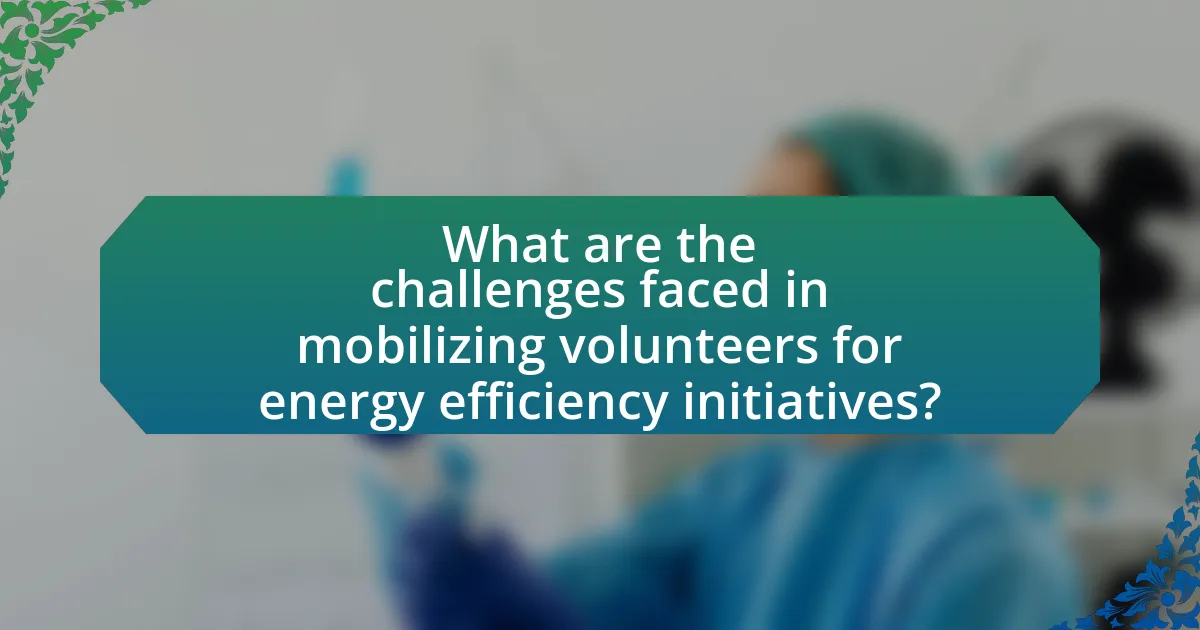
What are the challenges faced in mobilizing volunteers for energy efficiency initiatives?
Mobilizing volunteers for energy efficiency initiatives faces several challenges, including lack of awareness, limited time availability, and insufficient incentives. Many potential volunteers are unaware of the importance of energy efficiency or how they can contribute, which hinders recruitment efforts. Additionally, individuals often have busy schedules, making it difficult for them to commit time to volunteer activities. Research indicates that providing clear benefits, such as community recognition or skill development, can enhance volunteer engagement, yet many initiatives fail to offer these incentives, further complicating mobilization efforts.
What common barriers prevent individuals from volunteering?
Common barriers that prevent individuals from volunteering include lack of time, lack of awareness about opportunities, and perceived lack of skills. Many potential volunteers cite busy schedules as a primary reason for not engaging in volunteer activities, with studies indicating that over 60% of individuals feel they do not have enough time to commit. Additionally, a significant number of people are unaware of available volunteer opportunities, which can be attributed to insufficient outreach and communication from organizations. Lastly, individuals often believe they lack the necessary skills or qualifications to contribute effectively, leading to hesitation in volunteering. This perception is supported by surveys showing that nearly 40% of respondents feel unqualified to volunteer in certain roles.
How can organizations address misconceptions about energy efficiency?
Organizations can address misconceptions about energy efficiency by implementing educational programs that provide clear, factual information about energy-saving practices and technologies. These programs can include workshops, webinars, and informational materials that debunk common myths, such as the belief that energy-efficient products are too expensive or that energy efficiency does not significantly reduce costs. Research from the American Council for an Energy-Efficient Economy indicates that energy-efficient measures can lead to savings of 10-30% on energy bills, demonstrating the financial benefits of adopting such practices. By actively engaging the community through outreach and providing accessible resources, organizations can effectively change perceptions and encourage the adoption of energy-efficient behaviors.
What strategies can be implemented to overcome time constraints for potential volunteers?
To overcome time constraints for potential volunteers, organizations can implement flexible scheduling, task prioritization, and micro-volunteering opportunities. Flexible scheduling allows volunteers to choose times that fit their availability, increasing participation rates. Task prioritization ensures that essential activities are highlighted, enabling volunteers to focus on impactful contributions within limited timeframes. Micro-volunteering, which involves short, manageable tasks that can be completed in brief periods, caters to those with tight schedules, making it easier for them to engage without a significant time commitment. These strategies have been shown to enhance volunteer engagement, as evidenced by studies indicating that organizations offering flexible options see a 30% increase in volunteer retention rates.
How can organizations measure the effectiveness of their volunteer mobilization efforts?
Organizations can measure the effectiveness of their volunteer mobilization efforts by tracking key performance indicators (KPIs) such as volunteer retention rates, the number of volunteers recruited, and the impact of volunteer activities on campaign goals. For instance, a study by the Corporation for National and Community Service found that organizations with structured volunteer programs saw a 20% increase in volunteer retention compared to those without. Additionally, surveys and feedback from volunteers can provide qualitative data on their experiences and motivations, further informing the effectiveness of mobilization strategies.
What metrics should be used to evaluate volunteer engagement?
To evaluate volunteer engagement, key metrics include volunteer retention rates, hours volunteered, and participant satisfaction scores. Volunteer retention rates indicate the percentage of volunteers who continue to participate over time, reflecting their commitment and satisfaction with the organization. Hours volunteered measure the total time contributed by volunteers, providing insight into their level of involvement and the effectiveness of engagement strategies. Participant satisfaction scores, often gathered through surveys, assess volunteers’ experiences and perceptions, helping organizations identify areas for improvement. These metrics collectively offer a comprehensive view of volunteer engagement and its impact on local energy efficiency campaigns.
How can feedback from volunteers improve future campaigns?
Feedback from volunteers can significantly enhance future campaigns by identifying strengths and weaknesses in campaign strategies. When volunteers share their experiences, they provide insights into what worked well and what did not, allowing campaign organizers to refine their approaches. For instance, a study by the National Volunteer Fire Council found that incorporating volunteer feedback led to a 30% increase in volunteer retention rates in community programs. This demonstrates that actively seeking and implementing volunteer feedback can lead to more effective and engaging campaigns, ultimately improving overall outcomes.
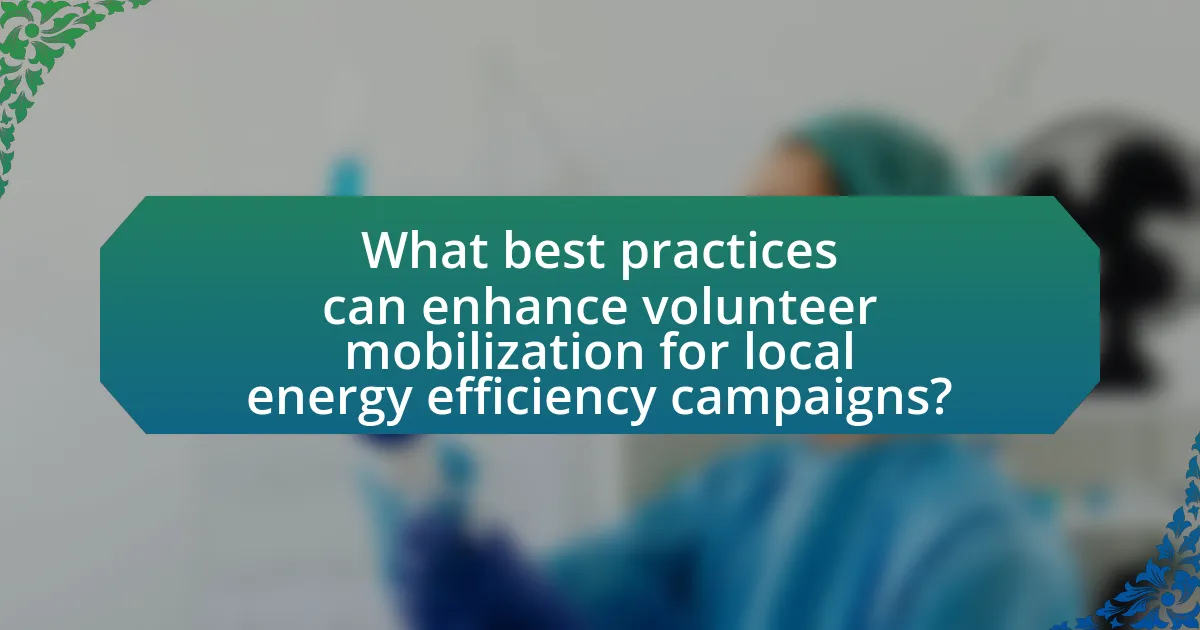
What best practices can enhance volunteer mobilization for local energy efficiency campaigns?
Effective volunteer mobilization for local energy efficiency campaigns can be enhanced through clear communication, targeted recruitment, and ongoing engagement. Clear communication ensures that volunteers understand the campaign’s goals and their roles, which can be achieved by providing detailed information and regular updates. Targeted recruitment focuses on engaging individuals who are passionate about sustainability and energy efficiency, utilizing social media and community events to reach potential volunteers. Ongoing engagement involves recognizing volunteer contributions and providing opportunities for skill development, which fosters a sense of community and commitment. Research indicates that campaigns with structured volunteer management practices see a 30% increase in volunteer retention rates, demonstrating the effectiveness of these best practices.
How can partnerships with local businesses support volunteer efforts?
Partnerships with local businesses can significantly enhance volunteer efforts by providing resources, visibility, and community engagement. Local businesses can offer financial support, in-kind donations, or venues for volunteer activities, which can increase the capacity and reach of volunteer initiatives. For instance, a study by the Corporation for National and Community Service found that businesses that engage in community service see a 20% increase in employee morale and productivity, which can lead to more robust volunteer participation. Additionally, local businesses can promote volunteer opportunities through their networks, attracting more volunteers and fostering a sense of community involvement.
What incentives can be offered to encourage volunteer participation?
Incentives that can be offered to encourage volunteer participation include recognition programs, skill development opportunities, and tangible rewards. Recognition programs, such as certificates or public acknowledgment, can enhance volunteers’ sense of value and belonging, which is supported by studies showing that appreciation increases volunteer retention rates. Skill development opportunities, such as training sessions or workshops, not only equip volunteers with useful skills but also enhance their employability, as evidenced by research indicating that volunteers often seek personal growth through their experiences. Tangible rewards, such as gift cards or merchandise, can also motivate participation, with surveys revealing that volunteers are more likely to engage when they perceive a direct benefit.
How can recognition programs boost volunteer morale and retention?
Recognition programs can significantly boost volunteer morale and retention by fostering a sense of appreciation and belonging among volunteers. When volunteers receive acknowledgment for their contributions, it enhances their motivation and commitment to the cause. Research indicates that organizations with recognition programs experience a 31% lower turnover rate among volunteers, as highlighted in a study by the Corporation for National and Community Service. This demonstrates that effective recognition not only uplifts individual spirits but also strengthens the overall volunteer community, leading to sustained engagement in initiatives such as local energy efficiency campaigns.
What practical tips can organizations implement to successfully mobilize volunteers?
Organizations can successfully mobilize volunteers by clearly defining roles and responsibilities, which enhances engagement and accountability. Providing specific tasks allows volunteers to understand their contributions and the impact they can make. Additionally, organizations should utilize effective communication strategies, such as regular updates and feedback, to keep volunteers informed and motivated. Research indicates that organizations with structured volunteer programs see a 50% increase in volunteer retention rates, demonstrating the importance of organization and communication in volunteer mobilization.
How can social media be leveraged to attract volunteers?
Social media can be leveraged to attract volunteers by creating targeted campaigns that highlight the impact of volunteer work on local energy efficiency initiatives. Engaging content, such as success stories and testimonials from past volunteers, can motivate potential volunteers by showcasing the tangible benefits of their involvement. According to a study by the Corporation for National and Community Service, 63 million Americans volunteered in 2017, demonstrating the effectiveness of outreach through social platforms. Utilizing specific hashtags and local community groups on platforms like Facebook and Instagram can further enhance visibility and engagement, leading to increased volunteer sign-ups for energy efficiency campaigns.
What are the key elements of a successful volunteer recruitment campaign?
The key elements of a successful volunteer recruitment campaign include clear messaging, targeted outreach, and effective engagement strategies. Clear messaging articulates the mission and impact of the campaign, making it easier for potential volunteers to understand their role and the significance of their contribution. Targeted outreach involves identifying and reaching specific demographics that align with the campaign’s goals, ensuring that recruitment efforts are efficient and impactful. Effective engagement strategies, such as providing training, recognition, and opportunities for feedback, help retain volunteers and foster a sense of community. Research indicates that campaigns with these elements see higher volunteer retention rates and increased participation, as evidenced by a study from the Corporation for National and Community Service, which found that structured recruitment and engagement practices significantly enhance volunteer involvement.
